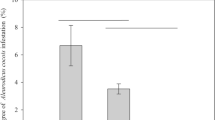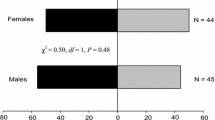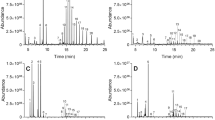Abstract
Nine Scolytidae (Cryphalus piceae, Cryphalus abietis, Pityokteines curvidens, Dendroctonus micans, Ips sexdentatus, Ips typographus,Orthotomicus erosus, Tomicus piniperda, andPhloeosinus bicolor) were subjected to olfaction tests on ten conifer species taken two by two. These conifers wereAbies cephalonica, Abies nordmanniana, Picea abies, Picea orientalis, Pinus pinaster, Pinus sylvestris, Pinus brutia, Pinus laricio,Cupressus atlantica, andCupressus sempervirens. A statistical study of the results, by means of the factorial analysis of correspondence completed by the duo preference test, commonly used in sensory analysis, revealed a taxonomic clustering by genus of the plant species and analogous specific attraction behavior for the insects.Pityokteines curvidens has a behavior analogous to that of the twoCryphalus considered.Phloesinus bicolor shows a very strong specificity forCupressus. The essential oils of the conifers were analyzed to determine their terpene composition and the ten odor spectra thus obtained were compared. The hierarchical classification, using a Euclidian distance, brought out similarities in the spectra, especially in the case ofPinus. It is shown that definitive establishment of Scolytidae is not due to the presence in the odor spectrum of any particular terpenoid. The attractive power of a species results from the synergism of the different terpenes. Moreover the definitive establishment of the insects also depends on their sensorial adaptation to volatile substances which can be wider or narrower for the species studied.
Similar content being viewed by others
References
Baker, J.E., andNorris, D. M. 1968a. Further biological and chemical aspects of host selection byScolytus multistriatus.Ann. Entomol. Soc. Am. 61:1248–1255.
Baker, J.E., andNorris, D.M. 1968b. Behavioral responses of smaller European Elm bark beetleScolytus multistriatus, to extract of non-host tree tissues.Entomol. Exp. Appl. 11:464–469.
Callahan, R.Z. 1966. Nature of resistance of pines to bark beetles, pp. 197–201,in H.D. Gerhold, E.J. Schreiner, R.E. McDermott, and J.A. Winieski. Breeding Pest-Resistant Trees. Pergamon Press, New York.
Chararas, C. 1958. Rôle attractif de certains composants des oléorésines à l'égard des Scolytidae des résineux.C.R. Acad. Sci. 247:1653–1654.
Chararas, C. 1959. L'attractivité exercée par les conifèeres à l'égard des Scolytidae et le rôle des substances terpéniques extraites des oléorésines.Rev. Pathol. Végét. Entomol. Agric. 38:113–125.
Chararas, C. 1960. Le chimiotropisme chez les Scolytidae et le rôle des substances terpéniques.Congr. Int. Vienne 2:249–254.
Chararas, C. 1962. Etude biologique des Scolytidae des coniferes. Ed. Lechevalier, Paris, 556 pp.
Chararas, C., andMsadda, K. 1970. Attraction chimique et attraction sexuelle chez lesOrthotomicus erosus (Coléoptère: Scolytidae).C.R. Acad. Sci. 273D:1877–1879.
Chararas, C. 1973. Attraction chimique exercée par divers conifères sur trois Scolytidae du genreOrthotomicus. C.R. Soc. Biol. Fr. 165(5):634–637.
Chararas, C. 1980. Ecophysiologie des insectes parasites des forêts. Ed. Chararas, Paris, 297 pp.
Chararas, C., Riviere, J., Ducauze, C., Delpui, G., Rutledge, D., andGazelles, M.-T. 1980. Bioconversion d'un composé terpénique sous l'action d'une bactérie du tube digestif dePMoeosinus armatus.C.R. Acad. Sci. 291D:299–302.
Dixon, J.B. 1975. BMDP Statistical Software. University of California-Los Angeles.
Gerhold, H.D. 1966. In quest of insect-resistant forest trees, pp. 305–318,in H.D. Gerhold, E.J., Schreiner, R.E. McDermott, and J.A. Winieski. Breeding Pest-Resistant Trees. Pergamon Press, New York.
Gurevitz, E., andIshaaya, I. 1972. Behavioural response or the fruit tree bark beetleScolytus mediterraneus, to host and nonhost plants.Entomol. Exp. Appl. 15:175–182.
Hughes, P.R.,andPitman, G.B. 1970. A method for observing and recording the flight behavior of tethered bark beetles in response to chemical messengers.Contrib. Boyce Thompson Inst. 24:329–336.
Lebart, L., andFenelon, J.P. 1973. Statistique et Informatique apliquées, 2nd ed. Dunod, Paris, 457 pp.
Mustaparta, H. 1975. Behavioural responses of the pine weevilHylobius abietis (col. Curculionidae) to odors activating different groups of reception cells.J. Comp. Physiol. 102:57–63.
Nijholt, W.W., andSchönherr, J. 1976. Chemical response behaviour of scolytids in West Germany and western Canada. Bi-mon Res Notes, 32(6):31–33.
Oksanen, H., Perttunen, V., andKangas, E. 1970. Studies on the chemical factors involved in the olfactory orientation ofBlastophagus piniperda (Coleoptera: Scolytidae).Contrib. Boyce Thompson Inst. 24(13):299–304.
Ozols, G.,Biceuskis, M., andGalvans, U. 1973. Terpenes and Their Complexes as Primary Attractants for Bark Beetles, pp. 24–28. Zashchita lesa-Riga, Latvian SSR Izdatel stvo Zinatne.
Perttunen, V. 1970. Aspects of the external and internal factors affecting the olfactory orientation ofBlastophagus piniperda.Contrib. Boyce Thompson Inst. 24:293–297.
Pitman, G.B. 1971.Transverbenol and α-pinene: Their utility in manipulation of the mountain pine beetle.J. Econ. Entomol. 64:426–430.
Renwick, J.A.A., andVité, J.P. 1970. Systems of chemical communication inDendroctonus.Contrib. Boyce Thompson Inst. 24(13):283–292.
Renwick, J.A.A., Hughes, P.R., andTantetin, J. 1973. Oxidation products of pinene in the bark beetleDendroctonus frontalis.J. Insect Physiol. 19:1735–1740.
Roessler, E.B., Pangborn, R.M., Sidel, J.L., andStone, H. 1978. Expanded statistical tables for estimating significance in paired-preference, paired difference, duo-trio and triangle tests.J. Food Sci. 43:940–943.
Rudinsky, J.A. 1966a. Scolytid beetles associated with Douglas fir: Response to terpenes. Science 152:218–219.
Rudinsky, J.A. 1966b. Observation on olfactory behaviour of scolytid beetles associated with Douglas fir forest.Z. Angew. Entomol. 58:356–361.
Smith, R.H. 1966. Resin quality as a factor in the resistance of pines to bark beetles, pp. 189–196,in H.D. Gerhold, E.J. Schreiner, R.E. McDermott, and J.A. Winieski. Breeding Pest-Resistant Trees. Pergamon Press, New York.
Author information
Authors and Affiliations
Rights and permissions
About this article
Cite this article
Chararas, C., Revolon, C., Feinberg, M. et al. Preference of certain scolytidae for different conifers. J Chem Ecol 8, 1093–1109 (1982). https://doi.org/10.1007/BF00986980
Received:
Revised:
Issue Date:
DOI: https://doi.org/10.1007/BF00986980




